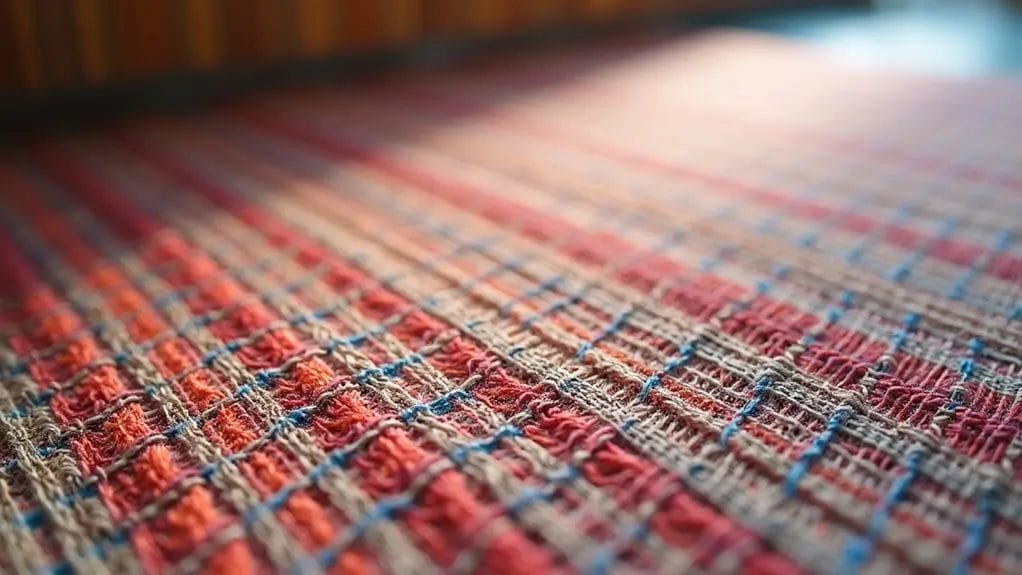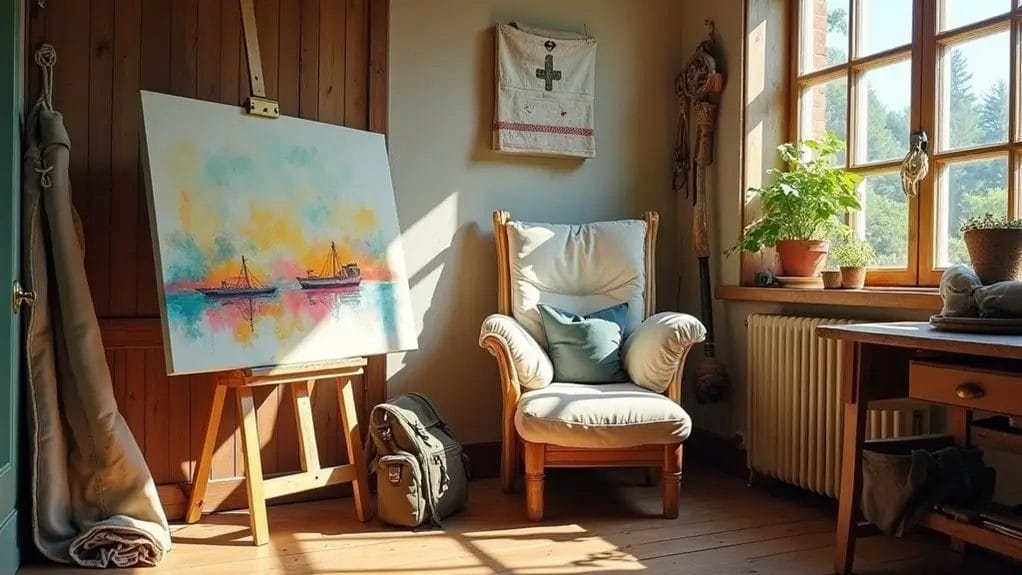You'll find canvas fabric at the intersection of durability and versatility, making it a cornerstone material across multiple industries. From heavy-duty work clothing to fine art paintings, canvas's tightly woven construction and resilient fibers deliver exceptional performance under diverse conditions. While its origins trace back to ancient sailing vessels, modern manufacturing techniques have expanded canvas's applications far beyond its maritime roots. Understanding this material's full potential can transform your approach to textile selection in both professional and personal projects.
Key Takeaways
- Canvas is widely used in outdoor gear like tents, backpacks, and boat covers due to its exceptional durability and weather resistance.
- Fashion and apparel industries utilize canvas for technical outerwear, structured bags, sturdy footwear, and heavy-duty workwear garments.
- Home décor applications include wall art, upholstery, floor cloths, room dividers, and custom window treatments.
- Marine applications rely on canvas for sailcloth production, combining strength and weather resistance for optimal performance.
- Canvas serves as a durable material for protective covers and industrial applications where tear resistance and weather protection are essential.
Why Canvas is Considered a Durable Fabric

Three key structural elements make canvas one of the most durable textile materials available.
First, you'll find its exceptional strength comes from tightly woven yarns in a plain weave construction.
Second, the fabric's durability stems from using heavy-duty fibers - traditionally cotton or synthetic fibers like polyester.
Third, the dense thread count creates a robust structure that resists tears and punctures.
You'll notice canvas's superior strength-to-weight ratio compared to other textiles.
The combination of high-quality fiber selection, specialized weaving techniques, and finishing processes guarantees maximum tensile strength.
This structural integrity makes it ideal for heavy-duty applications where durability is paramount.
How is Canvas Fabric Made?

While the manufacturing process varies by producer, canvas fabric production typically follows a standardized sequence of fiber preparation, yarn spinning, and weaving operations.
You'll find that cotton canvas begins with raw cotton fibers being cleaned and carded to align the fibers. These fibers are then spun into strong yarns using ring spinning or open-end spinning methods.
The yarns undergo plying to increase strength before being woven on industrial looms using a plain weave pattern. During production, the fabric's density and weight are controlled through yarn specifications and weave tension.
The final process includes finishing treatments to enhance durability and water resistance.
Common Uses of Canvas

Canvas fabric's versatility spans multiple industries, from fashion applications like durable footwear and structured bags to home décor elements including upholstery and wall hangings.
You'll find canvas extensively used in fine art as painting surfaces and in craft projects that require sturdy, workable materials.
The fabric's robust characteristics make it ideal for outdoor and recreational equipment, such as tents, backpacks, and marine applications where weather resistance and durability are essential performance requirements.
Canvas in Fashion and Apparel
Durable and versatile, cotton canvas has established itself as a cornerstone material in contemporary fashion and apparel design. The fabric used in fashion applications ranges from lightweight to heavyweight variants, offering varying degrees of water-resistant properties and cost-effectiveness.
- Technical outerwear: Performance jackets, outdoor vests, and utilitarian wear for adventure sports
- Accessories: Structured totes, crossbody bags, and durable backpacks for everyday use
- Footwear: Sneakers, deck shoes, and casual footwear requiring abrasion resistance
- Workwear: Heavy-duty pants, aprons, and protective garments for industrial applications
This product's adaptability makes it a preferred choice for both functional and aesthetic design elements.
Canvas for Home Décor
Beyond its applications in fashion, the versatility of canvas extends into interior design and home décor applications.
You'll find canvas serving as a foundational medium for wall art, from basic prints to elaborate oil paintings. The material's durable construction makes it ideal for upholstery, throw pillows, and decorative slipcovers.
In your home's high-traffic areas, canvas floor cloths offer practical alternatives to traditional rugs.
The fabric's tight weave and sturdy composition allow for custom room dividers, while its paintable surface enables personalized window treatments.
You can also utilize canvas for crafting distinctive lampshades, storage solutions, and statement wall hangings.
Canvas in Art and Craft
Through centuries of artistic development, painters and craftspeople have established canvas as their primary substrate for creative expression.
Canvas's shift from fresco and panel supports marked a revolutionary change in artistic practices since renaissance painters adopted it.
You'll find canvas used for painting across multiple disciplines:
- Oil painting - The fabric's weave provides ideal tooth for paint adhesion
- Acrylic painting - Canvas's flexibility accommodates various painting techniques
- Mixed media - The durable support handles collage and heavy applications
- Digital printing - Modern canvas accepts high-quality image transfers
The material's versatility, portability, and archival properties continue making it an indispensable medium for artistic creation.
Canvas for Outdoor and Recreational Gear
Canvas's practical applications extend far beyond the artist's studio into the domain of outdoor and recreational equipment manufacturing.
You'll find canvas material extensively used in sailcloth production, where synthetic blends enhance durability and weather resistance.
Modern tent manufacturing relies on treated canvas for its water-repellent properties and robust structure.
The outdoor industry utilizes canvas in backpacks, duffle bags, and camping gear, appreciating its tear-resistant nature and ability to withstand harsh conditions.
When properly treated, canvas offers exceptional UV protection and moisture resistance, making it ideal for boat covers, awnings, and recreational vehicle accessories.
Its versatility in outdoor applications stems from its tight weave and substantial weight.
How to Choose the Right Canvas Fabric

Selecting the ideal canvas fabric requires you to first evaluate your project's specific requirements, including factors like weather exposure, load-bearing needs, and intended application.
You'll need to analyze the fabric's technical specifications, such as thread count, weight classification (measured in ounces per square yard), and fiber composition to guarantee appropriate durability for your intended use.
Your selection process should incorporate a systematic assessment of texture characteristics and cost-effectiveness while maintaining focus on performance standards that match your project parameters.
Assessing Your Project Needs
Before starting any canvas-based project, you'll need to evaluate several critical parameters to determine the most suitable canvas specification for your application.
- Assess the longevity requirements - synthetic materials offer superior durability compared to natural fibers for high-stress applications.
- Consider price constraints - available alternatives range from simple cotton duck to premium marine-grade canvas.
- Evaluate environmental exposure - UV resistance, water repellency, and mold resistance requirements will influence material selection.
- Determine functional specifications - weight capacity, tensile strength, and dimensional stability needs must align with your project's performance demands.
These parameters will guide you toward the best canvas selection while balancing performance and budget considerations.
Evaluating Durability and Longevity
Three key factors determine a canvas fabric's long-term performance: fiber composition, weave density, and protective treatments.
While traditional linen canvas made centuries ago proved durable for wooden ships' sails, modern canvas incorporates synthetic fibers that enhance longevity.
You'll find that tighter weave densities resist wear and tear more effectively, with thread counts above 10 oz offering superior strength for outdoor applications.
Consider UV-resistant coatings and water-repellent treatments that extend canvas life by up to 50%.
For maximum durability, look for marine-grade canvas with advanced fiber blends and specialized finishes - these typically outlast standard varieties by 3-5 years under similar conditions.
Choosing the Right Texture
The ideal canvas texture depends primarily on your intended application and environmental exposure conditions.
When selecting canvas used in commercial or industrial settings, you'll need to evaluate specific texture characteristics that align with your project requirements.
- Analyze the weave density - tighter weaves produce more weather-resistant surfaces ideal for outdoor applications.
- Consider thread count - higher counts made from cotton provide enhanced durability for heavy-duty use.
- Evaluate surface finish - smooth textures work better for printing while coarse textures suit upholstery.
- Assess market options - compare duck canvas versus plain weave to match your specific performance needs.
Balancing Quality and Budget
Cost-effectiveness in canvas selection requires strategic evaluation of both material quality and price points. You'll find that historically, ancient civilizations chose canvas for its durability-to-cost ratio, a principle that continues to popularize its use today.
In today's industry, you're faced with options ranging from premium cotton duck to synthetic blends that replace traditional materials.
While American-made canvas often commands higher prices, imported alternatives can offer comparable quality at lower costs.
Consider your project's specific demands - if it's load-bearing or weather-exposed, invest in higher grades. For indoor decorative applications, mid-range options typically suffice without compromising essential performance characteristics.
Frequently Asked Questions
Can Canvas Fabric Be Safely Washed in a Washing Machine?
You can machine wash most canvas fabrics on gentle cycle, but it is important to pre-treat stains, use cold water, and avoid harsh detergents. Heavy-duty canvas may require professional cleaning to maintain structural integrity.
Does Canvas Fabric Shrink After Getting Wet?
Yes, you'll experience significant shrinkage with untreated canvas when exposed to moisture. Natural cotton canvas can shrink up to 15% after initial wetting, while preshrunk or synthetic canvas variants exhibit minimal dimensional changes.
What's the Average Lifespan of Canvas Products With Regular Use?
You'll find that properly maintained canvas products typically last 5-10 years with regular use. However, your canvas's lifespan varies based on fiber quality, protective coatings, UV exposure, and maintenance protocols you implement.
Is Canvas Fabric Naturally Waterproof or Does It Need Treatment?
Canvas isn't naturally waterproof. You'll need to treat it with waterproofing agents like wax, silicone, or fluoropolymer coatings. While the tight weave offers some water resistance, full waterproofing requires specialized treatments for best performance.
Can Canvas Fabric Be Dyed or Printed on After Purchase?
You'll find canvas highly receptive to both post-purchase dyeing and printing processes. The fabric's cotton fibers readily accept reactive dyes, pigment inks, and screen printing methods, though pre-treatment may optimize your results.
Conclusion
Understanding canvas's diverse applications will help you make informed decisions for your specific needs. Whether you're selecting duck canvas for marine use, cotton canvas for artistic purposes, or synthetic blends for outdoor gear, consider the fabric weight, weave density, and finishing treatments. You'll find canvas's durability, weather resistance, and adaptability make it an ideal choice across multiple industries, from commercial applications to creative endeavors.


0 comments